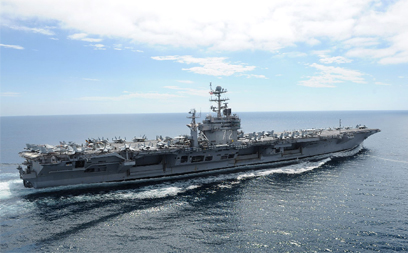


WASHINGTON - The Pentagon is bolstering US sea- and land-based defenses in the Persian Gulf in order to thwart any attempt by Iran to close the Strait of Hormuz, the Wall Street Journal reported Saturday.
The report cited defense officials as saying that the military has notified Congress of plans to preemptively place new mine-detection and clearing equipment and expand surveillance capabilities in and around the strait.
Related articles:
- 'Iran ready to wipe Israel off the map'
IAEA: Iran rapidly expands nuke work
Iran begins naval exercises near Gulf strait
The US military also wants to quickly modify weapons systems on ships to target Iranian fast-attack boats, as well as shore-launched cruise missiles, defense officials told the newspaper.

US aircraft carrier in Strait of Hormuz (Photo: EPA)
The readiness push, lead by the military's Central Command, indicates the extent to which war planners are taking tangible steps to prepare for a possible conflict with Iran, even as top White House and defense leaders try to emphasize other options over war.
The US' primary concern is that Iran could rapidly mine the strait and use heavily armed speedboats to attack or ram Western ships trying to clear the waterway. A successful Iranian attack on a US warship could drag the US into a larger conflict.
Upgrades to be installed by fall
According to the report, Central Command officials have told lawmakers they want the new mine-detection systems fielded before this fall, underlining the urgency of preparedness.
In addition, US special-operations teams stationed in the United Arab Emirates would take part in any military action in the strait should Iran attempt to close it, defense officials told the WSJ. A military official said these forces have been working to train elite local forces in Gulf nations including the UAE, Bahrain and Kuwait.
The officials said that the Pentagon submitted a request to Congress on February 7 on behalf of Central Command seeking to reallocate $100 million in defense funding to "bridge near-term capability gaps" in the Persian Gulf.
The newspaper released a list specifying the upgrades that the military has requested to bulk up its defenses, which also includes countermeasures against torpedoes, submarine detection equipment, remotely controlled antimine drones and improved naval guns. The Pentagon also seeks to purchase technologies to stop small vessels by entangling propellers.
Protecting the Strait of Hormuz, which has immense strategic and economic significance, is considered a top priority in preparing for a possible military conflict. US President Barak Obama and his administration have repeatedly voiced hopes that the financial sanctions placed on Iran would bring to the renewal of successful nuclear talks, but the Pentagon is readying for any possible development.
The tension between the US and Iran escalated in January when Tehran delivered a blunt warning that an American aircraft carrier that left the Persian Gulf through the Strait of Hormuz should not return. Determined to keep the waterway open, the US deployed a different aircraft carrier to the Gulf, and sent another warship near the area, prompting the Islamic Republic to back down from its threat.
- Receive Ynetnews updates
directly to your desktop















